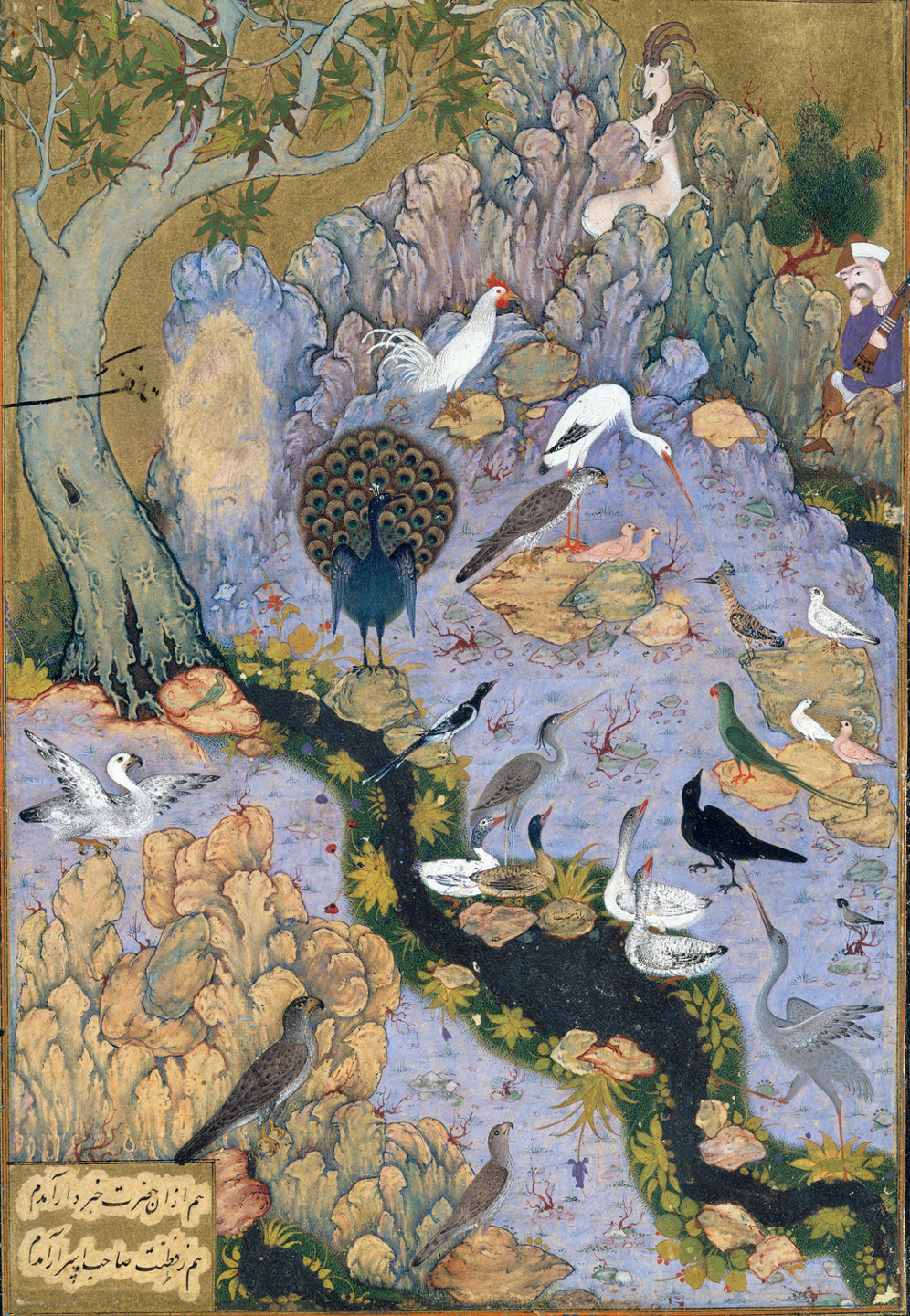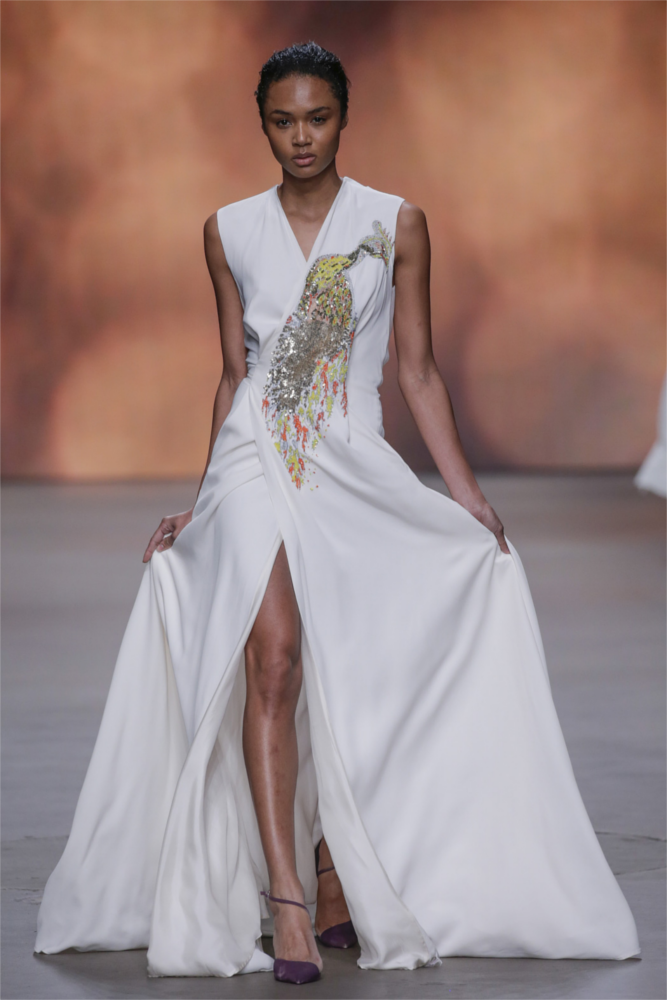The Conferences of the Birds
This mystical poem clearly lends itself to numerous interpretations and, even if the author is not himself a Sufi, the tale is full of Sufi references and meaning. The mystical and evocative nature of the plot has its visual counterpart in an exceptional medieval manuscript of the Conference, copied in Iran in the fifteenth century and now housed at the Metropolitan Museum, New York, where colorful and impressive illuminations and miniatures are on display.

Detail of The Concourse of the Birds, olio from a Mantiq al-tair (Conference of the Birds), by Farid al-Din ‘Attar. Isfahan (Iran),ca. 1600.
The Metropolitan Museum of Art.
Yet, despite its Medieval nature, it seems that the Conference can still be a source of artistic inspiration. This was the case for fashion designer Said Mahrouf, who, while collaborating with artist Yassine Mekhnache, developed a collection inspired by the medieval poem. The dresses in the collection, named after Attar’s work, balance the use of color with gorgeous embroideries representing the birds and their journey that recreate the mysticism and beauty of the Conference.
What is your background and how did you become a fashion designer?
I am originally from Morocco,born in Asilah but I grew up in Amsterdam in The Netherlands. There, I studied at the Art Academy, then moved back to Morocco. Before starting my career as a fashion designer, I was an artist developing installations, exhibitions, and performances. Clothing has always played a crucial part in the performances. I used to design costumes inspired by the specific architecture where the performance was taking place, whether it was a museum, a gallery or an historical location. Yet, when making performances, you need a great sum of money for every project and it got harder and harder for me and my fellow artists since art was receiving fewer and fewer resources. I saw people interested in the costumes I produced, even willing to buy them, and this is how I started as a fashion designer.
Generally speaking, what do you think characterises most your fashion production?
I think that fashion design has not much to do with fine art. In Dutch it is called a toegepaste kunst or applied art. So, even if my work as fashion designer can be influenced by architecture, in fact it remains deeply-rooted in the concept of the applied art: giving an everyday object an aesthetic dimension that is not art for art’s sake. Bigger fashion companies have the financial opportunity to invest in statement pieces or purely artistic collections. For me it is important that the dresses that I show on the runway can be actually bought and worn by people. Thus, for me it is design, it is not art. The technique that I use for designing my works is the moulage: draping the fabric directly on the mannequin. Also this largely influences my fashion production: the drapes and knots in my dresses come from this technique.

The Concourse of the Birds, olio from a Mantiq al-tair (Conference of the Birds), by Farid al-Din ‘Attar. Isfahan (Iran),ca. 1600.
The Metropolitan Museum of Art.

Said Mahrouf’s Spring/Summer 2016 collection, presented at the Mercedes-Benz FashionWeek Amsterdam, January 2016.
In your previous projects, have you ever taken inspiration from Islamic art or traditional crafts?
Before the collection inspired by The Conference of the Birds, I was not really considering Islamic art as a source of inspiration. I remember a client being very curious about this: why wasn’t I using the motives of Islamic art in my production? Probably because I was raised in Amsterdam and never took my Moroccan background in consideration when it came to performances or fashion design. Now that I have moved back to Casablanca I am more and more exposed to Islamic art as a whole and to traditional crafts, which are slowly influencing my production.
How did you have the idea for the collection and how did you develop it?
I got to know, thanks to a client, the embroideries created by French artist Yassine Mekhnache, and I was totally fascinated. He incorporates in his production this incredibly difficult Moroccan traditional technique of embroidery that takes much time and attention to detail. Yassine also travelled a lot around Morocco, in far-away and really remote villages, in order to learn and develop an expertise in the traditional craft of embroidery. In his work, he was using The Conferences of the Birds as a source of inspiration for his embroideries. I then read the Conference and I was fascinated by the story and its meaning. That’s how the idea of the whole collection has been developed. I prepared the dresses, than gave them to Yassine for the embroideries. We did not design the dresses and decorations beforehand: I created the dresses and sent them to Yassine to be embroidered. . It was open to him to interpret the designs with the embroideries. After that we judged the result and made any adjustment.
Which features of The Conference of the Birds do you think most influenced the design of the dresses and the collection as a whole?
As a designer I seek perfection: perfection in composition, perfection in shape and in color. Nature is perfect: colors’ juxtaposition you find in nature is perfect, and the same goes for its shapes and proportions. Thus, as a designer I try to get as close as possible to nature’s perfection. The Conference, in this sense, provided me some tools towards reaching this goal. For instance, the colors used reflect the colors of the birds described in the narration.
How did you have the idea for the collection and how did you develop it?
This project started as an experi – ment. I have collaborated with a variety of artists when producing performances and installations: choreographers, dancers, com – posers. This was actually the first time I was collaborating with an – other artist to produce a fashion collection. Also, it was an experiment since it was the first time I clearly matched Islamic cultural and artistic themes with the dresses I produced. I showed the collection for the first time at Fashion Forward Dubai and at the Mercedes Benz Fashion Week in Amsterdam, where we presented four additional models. The reactions were incredibly pos – itive: the collection was appreci – ated, both in the design and be – cause ofthe embroideries.

Said Mahrouf’s Spring/Summer 2016 collection, presented at the Mercedes-Benz FashionWeek Amsterdam, January 2016.


Wow! It is so beautiful and inspirational to me that you are living out your dream ♡.♡
Stay lovely
Reblogged this on Zahra's Blog.